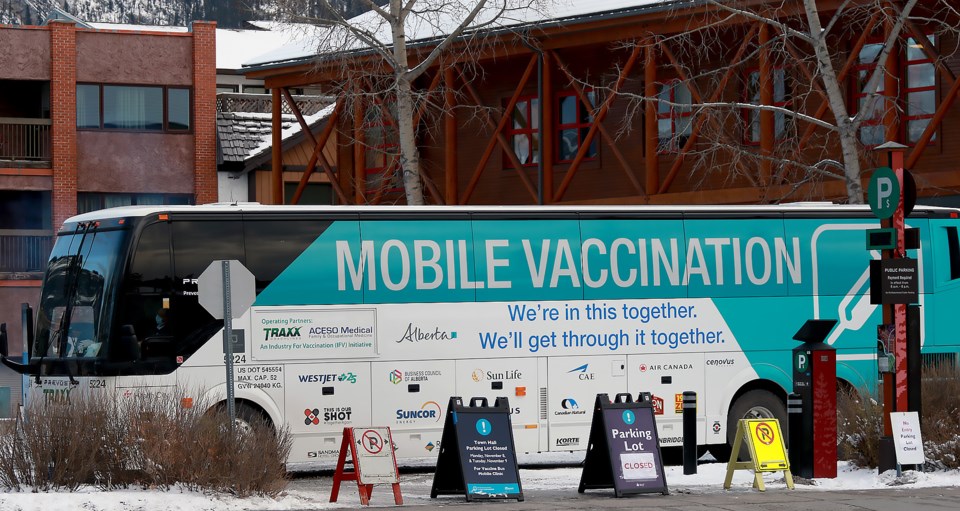BANFF – Vaccine passports must now include a QR code in order to get into businesses and other venues throughout the Bow Valley and across Alberta.
This change to the province’s vaccine passport system – referred to as the Restrictions Exemption Program – came into effect on Monday (Nov. 15).
Dr. Deena Hinshaw, the province’s chief medical officer of health, said this means Alberta vaccination records without a QR code, including paper immunization records received at vaccination appointments, will no longer be accepted.
“The only exception to this is First Nations and military vaccination records, which will continue to be accepted,” said Dr. Hinshaw during her COVID-19 briefing on Tuesday (Nov. 16).
As of Tuesday, Banff and Lake Louise had three active COVID-19 cases. There have been 1,131 cases since the pandemic began in spring 2020, including 1,127 recoveries and one death.
In neighbouring Canmore, there are seven active cases. A total of 626 cases have been recorded, including 617 recovered and two deaths.
There are 15 active cases in the MD of Bighorn, which takes in Stoney Nakoda First Nation at Morley, Harvie Heights, Exshaw and Lac Des Arcs. Since the pandemic began, there have been 897 cases, including 871 recoveries and 11 deaths.
Province-wide, there are 5,565 active cases. There are 518 people being treated for COVID-19 in hospital, including 101 in intensive care units.
An additional 13 deaths were reported over the previous 24 hours, bringing the provincial COVID-19 death roll to 3,201.
“While over the past few weeks, we have begun to come down the other side of the fourth wave, we have seen before how fast things can change,” said Dr. Hinshaw.
“I would like to remind Albertans that we must stay vigilant – especially as temperatures drop and we head into winter.”
Henshaw said this is important for two reasons.
“First, during wintertime, more activities move indoors where the risk of COVID-19 transmission increases,” she said.
“Second, it’s now influenza season, which means we can expect a rise in the number of Albertans with respiratory symptoms and other illnesses, including seasonal influenza.”
Last year, Hinshaw said the province had its strongest influenza vaccine campaign, resulting in more than 1.1 million Albertans receiving the flu shot.
She said uptake so far this year has been much slower, adding about 20 per cent of Albertans have been immunized against influenza.
Three seasonal influenza cases have been confirmed so far, but Dr. Hinshaw said fortunately there have been no severe outcomes reported.
“The flu shot won’t prevent COVID-19, but it will reduce your chances of getting sick with influenza and spreading it to others,” she said.
“While the flu is not as severe as COVID-19, it can be very serious for the very young and the very elderly, and it can put additional pressure on our health-care system.”
Meanwhile, for those eligible for their third COVID-19 vaccine dose, Hinshaw said it’s best to wait at least six months between the second and third shot based on available evidence.
Even though it may be tempting to get a booster as soon as possible, she said it’s important to remember that vaccine protection is not just for now, but for the future as well.
“By waiting the appropriate amount of time, you will receive greater protection from the vaccine,” she said.
Vaccination rates in the Bow Valley continue to slowly edge up.
In Banff and Lake Louise, 10,029 first doses have been administered and 8,912 people are fully vaccinated.
Canmore’s vaccination rate is harder to determine because the province lumps it in with all of Kananaskis Country, MD of Bighorn, Stoney Nakoda and West Rocky View Country.
For that entire region, 22,140 first doses have been administered and 20,505 people are fully vaccinated.
Meanwhile, to get a QR code as part of the vaccine passport program, visit alberta.ca/CovidRecords either save it to a phone or download it and print it off.
People can also visit a participating registry office where it can be printed for free, or call 811 to have your QR code mailed to you.




